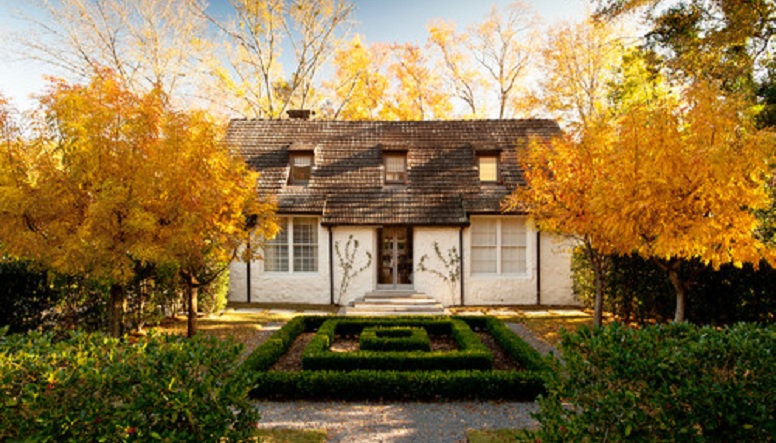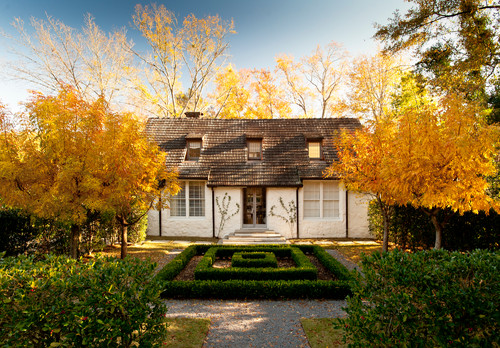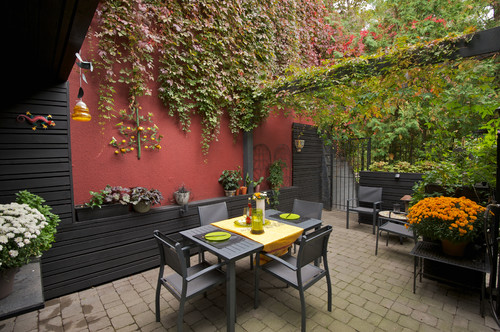PRUNING THROUGH THE LIFE OF A TREE
Here are four reasons to prune
For trusted expertise and superior results,
find a landscape professional near you.

Presented by the National Association of Landscape Professionals in partnership with 
By Lauren Dunec Hoang
Fall gardens are all about drama. The air turns crisp, and deciduous trees change from green to brilliant gold, rich amber and fiery red. Leaves rustle, ornamental grasses sway and catch the late-afternoon light. Rose hips and toyon berries look like clusters of jewels.
Whether you’d like to add a few containers to brighten your entryway, tuck in a patch of late-blooming flowers or choose a statement tree for an annual fall show, here are a dozen ideas to give you some inspiration for making your garden shine this season.

1. Showcase foliage. Adding at least one tree chosen for its fall foliage display can have a big impact in the garden. Here, the brilliant gold leaves of Chinese pistache (Pistacia chinensis, USDA zones 6 to 9;) glow in this neat and tidy front yard in Montgomery, Alabama.
Chinese pistache trees reach about 25 feet tall at maturity, making them a perfect choice for a courtyard or small garden. The leaves change from gold to crimson, offering a spectacular display even in warm winter climates. If pollinated by a nearby male tree, a female tree can become covered in decorative clusters of berries, which cling to the branches even after the leaves have fallen. The berries are a bit messy, but they’re a valuable food source for wild birds.
2. Add topiary. Formal, clipped topiary is a hardworking element in the fall garden that provides contrast, form and structure. The deep green leaves of boxwood (Buxus spp.), privet (Ligustrum spp.) or yew can provide a welcome foil for the season’s flashier foliage. The sculptural forms of topiary also contrast well with ornamental grasses and the informal branch structures of other shrubs. As you transition to a winter garden, the topiary can be wrapped with white lights for the holidays.
3. Create a spot to rest. A well-placed bench, pair of chairs or outdoor lounge can encourage you to slow down and appreciate the passing of the season. If you’re adding a new seating nook to your garden, look for places where you would naturally be inclined to relax, such as an area that catches the afternoon sun or a place against a wall to admire the garden from.

Here, a bench placed under a shimmering yellow katsura tree (Cercidiphyllum japonicum, zones 4 to 8) looks like the perfect spot to enjoy a steaming mug of apple cider. Fallen leaves, if left on planting beds, provide a natural mulch.

Grouping plants in swaths of color creates a much stronger visual impact than planting one plant here and one there. In this Pacific Northwest garden, layers of plant
5. Add fall bloomers. For a bright garden update, swap out tired-looking summer flowers with cheerful fall-blooming perennials.

By late summer, nurseries are stocked with flowers already in bloom, such as chrysanthemums, coneflowers, yarrows, black-eyed Susans and Leucanthemum; the latter two are pictured here. Select plants that look vigorous and are covered in buds (rather than in full bloom) for the longest display.

6. Style your courtyard. Early in the season, take advantage of the lingering warmth of summer and enjoy evenings outside. Here, a courtyard garden and an outdoor dining table have been made even more inviting with bright, colorful potted bedding mums. Covering the red wall behind, the leaves of Boston ivy (Parthenocissus tricuspidata, zones 4 to 10) will turn a deeper crimson for a curtain of color.
7. Incorporate ornamental edibles. Many cool-season veggies can be decorative in garden beds and provide a steady harvest through the holidays. To emphasize the plants’ distinctive forms, lay out your kitchen garden by considering each plant’s habit and mature height. For example, edge walkways with compact boxwood (Buxus sp.) to form a neat border. Place rosette-forming vegetables, such as cabbage and cauliflower, as the midlayer and place taller veggies, such as lacinato kale, sorrel and flowering fennel, at the back of the bed.
8. For trees, think beyond foliage. Fall fruits can be equally as dramatic as colorful leaves, and they stick around even after leaves fall. Even in warm-winter climates, persimmon trees offer a show throughout the season — and a rewarding harvest. The large oval leaves turn from green to orange and drop midfall, but the decorative, pumpkin-colored fruits continue to cling to the branches for weeks.
Harvest ‘Fuyu’ persimmons (Diospyros kaki ‘Fuyu’, zones 8 to 10) when the fruits turn orange and give slightly to the touch but are still firm. The fruits of ‘Hachiya’ persimmons (Diospyros kaki ‘Hachiya’, zones 8 to 10) are best left to ripen until the skin is nearly translucent and the flesh has the consistency of soft custard.
9. Add movement. Ornamental grasses sway with the slightest autumn breeze and add movement to the garden. Taller grasses with upright stalks, such as ‘Karl Foerster’ feather reed grass (Calamagrostis x acutiflora ‘Karl Foerster’) work well planted along fences and walls, while smaller, wispy grasses can be placed at the front of a border to soften a pathway.

10. Dress up your doorstep. A trio of fall-themed containers placed by the front door creates a welcoming entrance. For the most versatility, select pottery in warm and neutral colors so that you can use it throughout the year. Here, wispy bronze grasses, plum-colored coral bells (Heuchera sp., zones 4 to 9) and fragrant confederate jasmine (Trachelospermum jasminoides, zones 8 to 11) create an understated autumn display.

11. Contrast textures. Placing plants and garden elements with bold, structural forms (such as clipped shrubs, dense perennials and garden boulders) next to lighter, airy forms (ornamental grasses and wildflowers) creates more interest in the garden. Here, the dense wine-colored blooms of ‘Autumn Joy’ stonecrop (Sedum spectabile ‘Autumn Joy’, zones 4 to 11) contrast nicely with the feathery blades of fountain grass (Pennisetum alopecuroides, zones 5 to 10).

12. Fall strategy for warm-winter climates. Without the chill required for the leaves of most deciduous trees to change color, gardeners in Southern California, the Southwest and desert regions can create a fall display using warm-winter plants in a fall color palette. In this garden in San Luis Obispo, California, flame-colored leucadendron leaves catch the late-afternoon light, complemented by the green-gold fronds of pygmy date palms (Phoenix roebelenii, zones 9 to 11), luminous ornamental grasses and yellow-blooming red-hot poker (Kniphofia sp., zones 6 to 9). In the background, burgundy cabbage tree (Cordyline sp.) and blue-gray agaves deepen the color palette.
More from Houzz
Lay Vibrant Outdoor Rugs for Long-Lasting Color
We recently updated our Privacy Policy. By continuing to use this website, you acknowledge that our revised Privacy Policy applies.